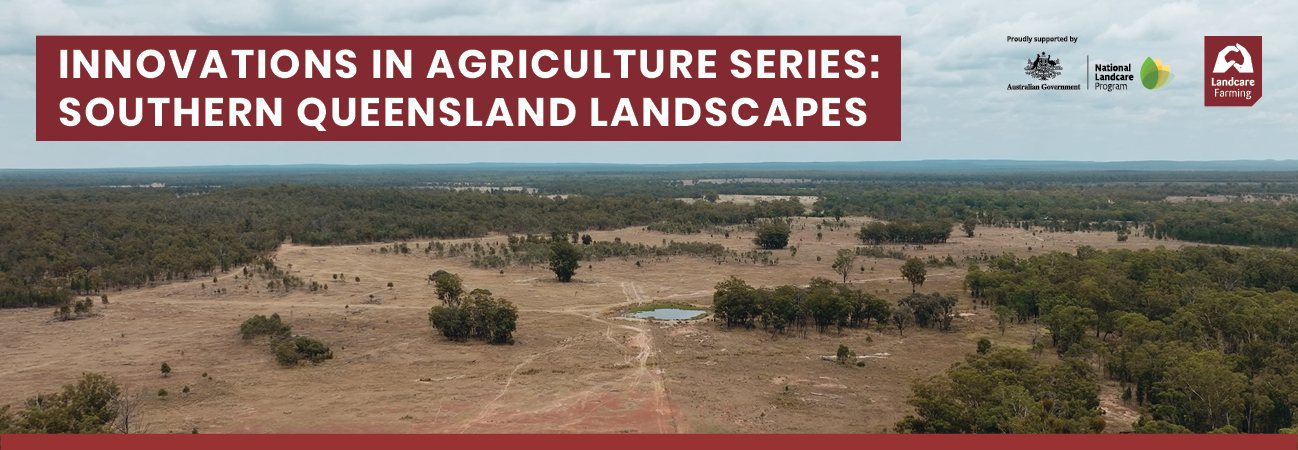
Exclusion Fencing and Land Rehydration Drive Drought Resilience and Profit
Business and biodiversity gains are just two benefits being realised from a Queensland livestock enterprise’s initiatives to keep wild dogs out.
Five years ago, Inglewood graziers Peter and Julie Ramsey reinstated an original exclusion fence around the perimeter of ‘Old Paisley’, an 800-hectare property which five generations of their family have worked on for over a century.
The Ramseys implemented a range of sustainable agricultural practices including exclusion fencing, land rehydration management, rotational grazing, multispecies pasture and dedicating areas of remnant vegetation to ‘Land for Wildlife’. Peter and Julie believe that together exclusion fencing and land rehydration have been key to agricultural and environmental gains, such as:
- A boost in carrying capacity by 500 DSE (Dry Sheep Equivalent), leading to an expansion of their 50 head breeding cow enterprise to a 25 head breeding cow mob with an additional 700 breeding goats and a number of sheep;
- Management of predator species, wild dogs and feral pigs, through exclusion fencing which has a known correlation with improved biodiversity outcomes;
- Better animal health outcomes including improved nutrition and fertility, increased growth rates and reduced mortality risk; and
- Better water holding capacity and improved year-round groundcover, which has improved climate resilience and supports higher stock numbers.
Wild dogs present a significant problem in southern Queensland, severely impacting agricultural enterprises and costing the sheep and beef industries between $64 million to $111 million annually through direct predation, harassment of livestock, disease and the cost of control methods (State of Queensland, 2021). Wild dogs also significantly reduce biodiversity by predating on native wildlife such as koalas (which are found on ‘Old Paisley’), wallabies, and birds, and can spread disease to domestic and native animals as well as humans.
With neighbouring properties experiencing stock losses of up to 80 percent due to wild dog predation and land managers in the area leaving the sheep industry due to the high number of sheep and lamb deaths, Peter and Julie knew that they had to take protective measures before expanding their grazing enterprise to include sheep and goats.
They replaced the original exclusion fence (parts of which dated back to 1927) with the support of Goondiwindi Regional Council and the State Government’s Queensland Feral Pest Initiative, taking care to ensure it deterred wild dogs while still allowing for echidnas and other native animals to travel underneath.
In the Ramsey’s experience, not only has exclusion fencing been the best option for addressing the wild dog issue but it has also helped them manage total grazing pressure. Reduced competition from native herbivores for pasture and the protection of stock from wild dogs has significantly improved the drought resilience of ‘Old Paisley’, allowing the Ramsey’s to now run goats and sheep, as well as cattle.
The Ramsey’s have also further increased drought resilience on their property by constructing low profile contour banks to increase soil water infiltration. This land rehydration technique increases drought resilience through improving infiltration of water into the soil, by slowing the flow of water across the landscape and spreading the water over a wider area.
“Water has gone from leaving the paddock in two hours to about four days” Peter says, and he notes that the increased water retention has not only significantly increased groundcover and pasture density, but reduced excessive runoff and erosion to further improve productivity and profitability.
The fantastic outcomes achieved by Peter and Julie at ‘Old Paisley’ have led to several neighbouring properties following their lead. Together these landholders have effectively created a cluster fenced area, amplifying the impact of the work on ‘Old Paisley’ and further improving resilience of local agricultural enterprises in the Inglewood area.
This case study was produced as part of the Landcare Farming Innovations in Agriculture Series. Supported by the Australian Government’s National Landcare Program, the Landcare Farming Innovations in Agriculture Series is managed in partnership by Landcare Australia and the National Landcare Network.
Explore the following resources to find out more about managing similar environments:



